|
|
 |
Resources for the Whole Community
Home >
Resources > Resources for the Whole Community
In order to provide more comprehensive and meaningful search results on
our site, several reports
are available for viewing and download directly from this web site. Kindly visit the main
sites of the author organisations for more complete and updated information.
We acknowledge our gratitude to the many people and sources whose work
has been drawn freely upon. We thank them all.
|
 |
India -
The Right to Information Act is an act to provide for setting out
the practical regime of right to information for citizens to secure access
to information under the control of public authorities, in order to promote
transparency and accountability in the working of every public authority,
the constitution of a Central Information Commission and State Information
Commissions and for matters connected therewith or incidental thereto. The
Government of India enacted the RTI Act 2005, which came into effect on
12th October 2005. |
|
 Facts for Life Facts for Life
Author: UNICEF, WHO, UNESCO, UNFPA, UNDP, UNAIDS, WFP and the World Bank
Publication date: April 2010
Languages: English French Spanish
The fourth edition of Facts for Life contains essential information that
families and communities need to know to raise healthy children. This
handbook provides practical advice on pregnancy, childbirth, childhood
illnesses, child development and the care of children. This edition also
features a new chapter on child protection. The book is intended for
parents, families, health workers, teachers, youth groups, women’s groups,
community organizations, government officials, employers, trade unions,
media, and non-governmental and faith-based organizations.
|
Mother-Child Protection Card
The Mother and Child Protection Card (MCP Card) has been introduced through a collaborative effort of the Ministry of Women and Child Development and the Ministry of Health & Family Welfare, Government of India
The MCP card is a tool for informing and educating the mother and family on different aspects of maternal and child care and linking maternal and childcare into a continuum of care through the Integrated Child Development Services (ICDS) scheme of Ministry of Women and Child Development and the National Rural Health Mission (NRHM) of the Ministry of Health & Family Welfare (MoHFW).
The card also captures some of key services delivered to the mother & baby during Antenatal, Intranatal & Post natal care for ensuring that the minimum package of services are delivered to the beneficiary.
MCP card has already been disseminated in the year 2010-11 for implementation by the States.
The MCP card helps in timely identification, referral and management of complications during pregnancy, child birth and post natal period. The card also serves as a tool for providing complete immunization to infants and children, early and exclusive breast feeding, complementary feeding and monitoring their growth.
 Mother-Child Protection Card and Guide Mother-Child Protection Card and Guide
Benefiting
- Families / Program participants
- Anganwadi workers of ICDS
- Integrated Child Development Schemes
- Nurse midwife
- Supervisors of health and ICDS
This guide book is to be used as a reference book by these functionaries of health and ICDS to focus on under three. The components are
- Safe Motherhood
- Care of the New born
- Child Growth and Development
- Nutrition
- Immunisation and
- The Importance of the Mother Child Protection Card
WHO - The
Health Academy's goal is to improve knowledge about attaining and
maintaining good health. Through eLearning - which is how WHO defines
learning by any electronic technology and media - the Organization has the
means to reach out to people with information on disease prevention and
health promotion. What is particularly important is the ability to reach
school-age children, those aged from 12-18 years.
WHO is in a unique position to provide this information with its access to
health expertise and rich information resources including those from its 193
Member States. |
|
Ministère de la Santé et de la Qualité de la Vie, Health IEC Unit, Republique de Maurice
Health Information, Education and Communication Unit at the Ministry of Health and Quality of Life, Mauritius
The following pamphlets on Diabetes, Obesity, Healthy Nutrition, Alcohol abuse and Cigarette smoking are in French. For each topic, there is a recto (front) and verso (back) file. You just have to fix the recto on the verso (back to back), fold it into three and you get your pamphlet.
All document are in pdf  format format
L´ALCOOL source de vos problemes - Alcohol Abuse :
Recto/Front |
Verso/Back
LE DIABETE - Diabetes :
Recto/Front |
Verso/Back
DITES NON à la cigarette - Cigarette Smoking :
Recto/Front |
Verso/Back
L´OBÉSITÉ - Obesity :
Recto/Front |
Verso/Back
REPAS VARIÉES pour les diabétiques et pour tous - Healthy Nutrition :
Recto/Front |
Verso/Back
|
|

Get
Answers to all your Health Questions Online
Would you like a quick consult about a medical problem, symptom or just want
more information on a medical topic. This a FREE
service.
Patient education is an integral part of health care delivery across medical
centers in developed countries thus encouraging active patient participation
and ensuring far better compliance and patient satisfaction.
What started as a resource center eleven years back, with a modest
collection of material on patient education has grown into India's only
largest patient education center housing more than 11,000 authentic books on
possibly every aspect of health and diseases, along with pamphlets, health
care magazines, and an exhaustive audiovisual section too.
HELP was also documented to be the world's largest Free library on consumer
health information in the Limca book of records. State of the art
infertility specialists to the world, Founders and visionaries for HELP, our
Medical Directors have paved the path for the new "patient-centric health
care "revolution in India.
|
|
|
 |
Diarrhoea : Why children are still
dying and what can be done
14 October, 2009 -
New UNICEF/WHO Report Focuses Attention on Diarrheal Disease—the Second Leading Killer of Children Under 5—and Outlines 7-point Plan to Control This
Preventable and Treatable Illness
The report highlights the proven diarrheal disease prevention and treatment solutions already available today. Many children in the developing world
cannot access urgent medical care for severe illnesses, making prevention methods—including improved hygiene, sanitation, safe drinking water,
exclusive breastfeeding, and vaccines preventing rotavirus—critical components of diarrheal disease control. When diarrhea occurs, it can be
effectively treated with simple solutions, including oral rehydration therapy/oral rehydration solution, zinc and other micronutrients, and continued feeding.
Read more |
|
 |
Cartograms - Images of the Social and Economic World
On a regular map, the sizes of the countries of the world are in
proportion to their actual sizes on the surface of the planet and their
shapes are the same as their actual shapes. Here are redrawn maps with
the sizes of countries made bigger or smaller in order to represent something
of interest. Such maps are called cartograms and can be an effective
and natural way of portraying geographic or social data. Here are some
examples of Population, Gross domestic product, Child mortality, People
living with HIV/AIDS, Total spending on healthcare, Energy consumption
(including oil), and Greenhouse gas emissions. |
|
 |
Breast Crawl
Initiation of Breastfeeding by Breast Crawl
visit
breastcrawl.org for video and complete dossier.
UNICEF, WHO and WABA along with the scientific community strongly
recommend initiating breastfeeding within an hour of birth.
Evidence shows that early initiation can prevent 22% of all deaths
among babies below one month in developing countries.
Every newborn, when placed on the mother’s abdomen, soon after
birth, has the ability to find its mother’s breast all on its own and
to decide when to take the first breastfeed. This is called the
‘Breast Crawl’.
This method is evidence based and has been field tested by us. A
documentary on the ‘Breast Crawl’ has been prepared for training,
advocacy and for wider dissemination. The video has created a very
high level of sensitivity among all the levels of functionaries and
was officially endorsed by senior policy makers as the right approach
for initiating breastfeeding. This dossier provides the background and
a scientific overview to the documentary.
Initiation of breastfeeding by the Breast Crawl is a critical
component of the IYCF (Infant and Young Child Feeding) initiative for
the state of Maharashtra, India. IYCF deals with nutrition of children
from birth to 3 years of age, and also takes into consideration the
nutrition of pregnant and lactating mothers. Two critical components
of IYCF are breastfeeding and complementary feeding. Improved IYCF
practices promote optimal growth and development, prevent malnutrition
and improve child survival. With 40% of the children in the state
undernourished, this initiative becomes extremely critical.
UNICEF has facilitated partnerships with all stakeholders including
the State Government, State Nutrition Mission, the Integrated Child
Development Services (ICDS), Public Health Department, BPNI
(Breastfeeding Promotion Network of India), NGOs, Community Based
Organisations (CBOs) and several academic institutions, for this major
initiative. These partnerships are aimed at creating a revolution in
the state promoting IYCF practices.
We are sure that this documentary and dossier will greatly help
similar initiatives worldwide. It is our strong desire that this
information helps every mother and baby to experience the miracle of
Breast Crawl. If we all could achieve early initiation of
breastfeeding, we will be able to prevent 22% of all deaths among
babies below 1 month.
This can be achieved by training all health care providers to initiate
breastfeeding, by Breast Crawl, to give infants the best start in
life.
visit
breastcrawl.org for video and complete dossier.
|
|
Films for women in the community, community workers and health workers
Medical Aid Films (MAF -�MedicalAidFilms.org)
is a cutting edge film-making charity. We produce training films and
animations for grassroots health workers in low income countries. Our films
provide information and medical techniques on issues surrounding safe
childbirth and infant health, with the aim of saving the lives of vulnerable
women and children around the world.
Approximately one woman a minute dies in childbirth. We hope that by using
film and animation to train health workers, we can overcome literacy and
language barriers that so often impede learning.
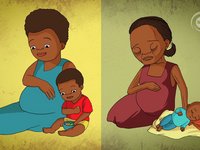
Warning Signs in Pregnancy
This film is aimed at community health workers, traditional birth attendants and women in the community. Its objective
is to educate them about the warning signs in pregnancy that they should be aware of, and the checks they should carry
out, so that skilled obstetric care can be sought out as soon ...
Reconnaitre les signaux d'alerte durant la grossesse
Ce film s’adresse aux femmes, aux travailleurs communautaires en sant�, aux
sages-femmes traditionnelles et aux communaut�s en g�n�ral.
Il a pour but de leur enseigner les signaux d’alerte lors de la grossesse
ainsi que les signes � rechercher, afin que les femmes enceintes qui les
pr�sentent re�oivent, au plus t�t, des soins obst�triques dispens�s par du
personnel qualifi�.

Neonatal Resuscitation - Skilled Health Worker Version
This teaching film is aimed at skilled health workers equipped with a stethoscope and a bag and a mask. It teaches
the essential steps to perform Neonatal Resuscitation, based on the Resuscitation Council UK's guidelines. � Medical Aid Films - 2011
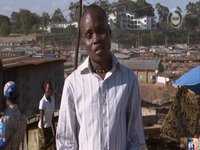
Understanding your body: How to plan a pregnancy
This film is aimed at teenagers and young adults and presents the various methods available to plan a pregnancy. � Medical Aid Films - 2011
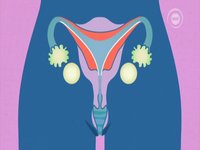
Understanding your body: How babies are made
This is a film aimed at early teens and young adults. It describes what puberty is and how babies are made using a
mixture of animation and expert advice as well as from vox-pop's from young men and women in Nairobi. � Medical Aid Films - 2011
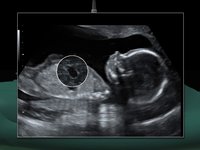
How to use the ultrasound probe
This animation is part of MAF's Basic Obstetric Ultrasound Module. Films of this module are to be used when training
midwives and clinical officers in basic obstetric ultrasound. MAF tested this film while training clinical officers and nurses in Mozambique. Very few people living in low resource areas
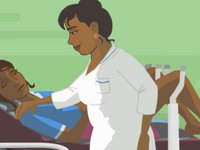
Cervical cancer screening: visual inspection of the cervix using acetic acid (VIA)
This is an animation showing a method of screening for cervical cancer in resource poor, developing countries. Test
such as the pap smear require access to skilled health care and labs for testing samples and HPV (the virus responsible for most cervical cancers) testing kits remain expensive, yet VIA
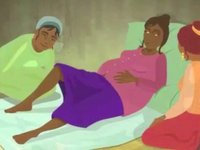
Ten steps to safe delivery
This follows Neema a village birth attendant while she helps to deliver a baby in a rural setting where there is no access to trained health
care workers. The 10 key steps for the audience to learn are then repeated at the end of the film to ensure that they are taking away the correct message.
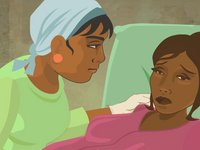
Management of PPH - Low resource setting
This animation is aimed at women and TBAs. It teaches how to prevent and manage PPH in settings where skilled obstetric
care can be reached within a reasonable period of time (less than four hours). It includes the use of Misoprostol. � Medical Aid Films - 2011
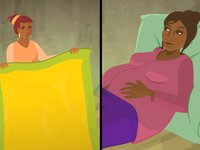
Management of PPH - No resource setting
Primary Post-partum Haemorrhage (PPH) is one of the major causes of maternal death in the developing world. This
animation is aimed at women and TBAs. It teaches how to prevent and manage PPH in settings where it would take the
woman more than 4 hours to reach skilled obstetric care. It demonstrates
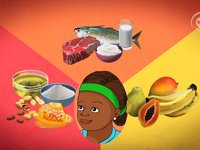
Food for Life: What Pregnant Women Need to Eat
Ce que doivent manger les femmes enceintes
Ce film s’adresse aux femmes, aux travailleurs en sant� et aux communaut�s en g�n�ral.
Il leur enseigne les bases de l’alimentation que doit consommer une femme
enceinte ainsi que les complications qu’une alimentation saine permet
d’�viter. Il pr�sente les quatre groupes d’aliments (les aliments de base,
les aliments pour bouger, les aliments pour grandir et les aliments bonne
mine) et d�taille leurs bienfaits.
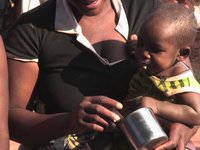
Food for life: What and when to feed you child?
Quand et comment nourrir
votre enfant - 6 � 24 mois
Ce film s’adresse aux femmes, aux travailleurs en sant� et aux communaut�s en g�n�ral.
Il leur enseigne les bases de l’alimentation d’un enfant entre les �ges de 6
mois et deux ans. Il pr�sente les quatre grandes cat�gories d’aliments (les
aliments de base, les aliments pour bouger, les aliments pour grandir et les
aliments pour avoir bonne mine) et d�taille leurs bienfaits.

Food for life: Breastfeeding
Allaitement maternel - 0 � 6 mois
Ce film s’adresse aux m�res, aux travailleurs en sant� et aux communaut�s en g�n�ral.
Il leur enseigne pourquoi et comment allaiter un nourrisson de la naissance
� l’�ge de 6 mois. Il explique les avantages du lait maternel sur le lait
artificiel, rappelle qu’il ne faut donner ni eau, ni tisane ni alimentation
compl�mentaire aux b�b�s avant l’�ge de 6 mois et d�montre comment allaiter.

The Story of MAF
With experts in the field of Obstetrics, Gynaecology, Midwifery and Paediatrics as founders and trustees of MAF
our focus lies on improving the conditions for mothers, infants and children in the developing world who have little or no access to essential health care.
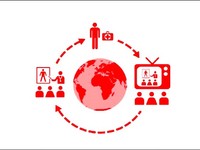
MAF: How we work
The growth in mobile technologies across the developing world allows us to blend the inspirational skills of media
and medical professionals together to produce our medical aid films. These films focus on bringing education and
knowledge to the people that need it the most, including health providers
|
Breastfeeding Gateway
CDC-- Newly Revised Health Communicator's Social Media Toolkit
download pdf pdf
"...The Health Communicator's Social Media Toolkit, originally
released in September 2010, is a resource designed to provide partners with
guidance and to share CDC's lessons learned in integrating social media into
health campaigns.
The second edition is now available with additional information on
developing trends in social media, best practices and a campaign example
highlighting Vital Signs, a monthly program that focuses on a single,
important health topic that provides a "call to action" for different
audiences. Updated information includes the following:
- Expanded Mobile Health section including information on mobile websites, downloadable applications and SMS text messaging.
- Increased capabilities of Twitter to include Twitter Chats, Twitterviews, and Twitter Town Halls.
- Enhanced best practices insight for Facebook, Twitter and Blogs.
Table of Contents
Social Media Introduction
Social Media Overview
Getting Your Feet Wet With Social Media
CDC's Top Lessons Learned from Using Social Media
Developing a Social Media Strategy
Social Media Monitoring and Evaluation
Governing Social Media Efforts
Social Media Tools
Buttons and Badges
Image Sharing
Content Syndication
RSS Feeds
Podcasts
Online Video Sharing
Widgets
eCards
Mobile Technologies
Twitter
Blogs
Facebook
Social Media Campaign Example
CDC Vital Signs Campaign
More Social Media Resources
Social Media Communications Strategy Worksheet
Social Media Evaluation Worksheet
References |
|
 |
Alcoholics Anonymous: The Story of How
Many Thousands of Men and Women Have Recovered from Alcoholism
Online Versions:
aa.org
| anonpress.org
It's more than a book. It's a way of life. Alcoholics Anonymous-the Big
Book-has served as a lifeline to millions worldwide. First published in
1939, Alcoholics Anonymous sets forth cornerstone concepts of recovery
from alcoholism and tells the stories of men and women who have overcome
the disease. With publication of the second edition in 1955, the third
edition in 1976, and now the fourth edition in 2001, the essential
recovery text has remained unchanged while personal stories have been
added to reflect the growing and diverse fellowship. The long-awaited
fourth edition features 24 new personal stories of recovery. Key features
and benefits �the most widely used resource for millions of individuals
in recovery �contains full, original text describing AA program �updated
with 24 new personal stories
About the Author
Alcoholics Anonymous (AA) is an informal meeting society for recovering
alcoholics whose primary purpose is to stay sober and help other
alcoholics achieve sobriety.AA suggests that alcoholics follow its
program and abstain from alcohol in order to recover from alcoholism, and
share their experience, strength, and hope with each other that they may
solve their common problem.AA was the first twelve-step program and has
been the model for similar recovery groups like Narcotics Anonymous.
Al-Anon/Alateen are programs designed to provide support for relatives
and friends of alcoholics. The organization was named after its primary
guidebook Alcoholics Anonymous, also known as The Big Book. Although AA
is not for everyone, there is growing evidence supporting the
effectiveness of AA as a treatment for alcoholism.
575 pages - Alcoholics Anonymous World Services; 4 Revised edition
(February 10, 2002) - English
ISBN-10: 1893007162, ISBN-13: 978-1893007161 |
Maharashtra, India
Guides
|

click to enlarge
|
Diarrhoea - Guide 3
Audience:
Govt. of India, Central Health Education Bureau, Ministry of health and
Family Welfare
May 1984
8 pages -
 pdf
2.5 mb pdf
2.5 mb |
|

click to enlarge
|
Marathi Cookbook
Iron and Vitamin C Rich Recipes
Gharchya Ghari Anaemia Tala
Audience:
June 2002
67 pages -
 pdf 2.8 mb pdf 2.8 mb |
|

click to enlarge
|
Management of Critically Sick Child
Audience:
Directorate of Health Services Maharashtra State
Department of Paediatrics, Cama & Albless Hospital, Mumbai
Maharashtra State Health Education Bureau, Aundh, Pune
1997-1998
41 pages -
 pdf 9.5 mb pdf 9.5 mb |
Posters
Advertising Materials
India
|

click to enlarge
|
National Guidelines on Infant and Young
Child Feeding
Audience:
Ministry of Human Resource Development, Department of Women and Child
Development, Food and Nutrition Board, Government of India
August 2004
37 pages -
 pdf 936 kb pdf 936 kb |
|

click to enlarge
|
National Guidelines on Infant Feeding
Audience:
Food and Nutrition Board, Department of Women and Child Development,
Ministry of Human Resources Development, Government of India.
1992
17 pages -
 pdf 2.5 mb pdf 2.5 mb |
|

click to enlarge
|
Policy on Control of Nutritional Anaemia
Audience:
Ministry of Health & Family Welfare, Government of India
January 1991
11 pages -
 pdf 1.7 mb pdf 1.7 mb |
|

click to enlarge
|
Prevention and Control of Nutritional
Anaemia: A South Asia Priority
Audience:
United Nations Children's Fund - Regional Office for South Asia
2002
16 pages -
 pdf 2 mb pdf 2 mb |
|

click to enlarge
|
Preventing and Controlling Iron Deficiency
Anaemia Through Primary Health Care
Audience: A Guide for Health Administrators and Programme Managers
E. M. DeMaeyer
Formerly Medical Officer, Nutrition, World Health Organization,
Geneva, Switzerland
with the collaboration of
P. Dallman, J. M. Gurney, L. Hallberg, S. K. Sood & S. G. Srikantia
1989
61 pages -
 pdf 1.7 mb pdf 1.7 mb |
|

click to enlarge
|
Measles Control: An Urban Challenge
Audience:
National Immunization Programme, Government of India
1998
32 pages -
 pdf 4.3 mb pdf 4.3 mb |
|

|
Sahyogini
Animator to guide Self Help Groups
Audience:
All NGOs, Institutes and Persons working in the Self Help Group Movement.
Abstract:
This book is based on the experiences and achievements of the Maharashtra
Rural Credit Programme. Sahyogini (Animator) is the back bone of this
programme working in the villages with the Self Help Group to Guide & Help
them by providing technical support. This book is focused on the working
procedure of the Self Help Group Dynamics, Formation, Structure, working
procedure etc. This guide answers frequently asked questions.
41 pages -
 pdf 3 mb pdf 3 mb |
Vitamin A: Frequently Asked Questions - English
Vitamin A:
Frequently Asked Questions - Marathi -
 pdf 49 kb pdf 49 kb
Vitamin A Marathi brochure -
 pdf 470 kb pdf 470 kb
The great Vitamin A fiasco - World Nutrition - May 2010
Michael Latham
This commentary challenges the wisdom and validity of the current practice
of providing to children between 6 months and 5 years, regular supplements
of massive medicinal doses of vitamin A. Every year, roughly half a billion
capsules are made to be distributed and to be given to around 200 million
children in over 100 ‘targeted’ countries (1,2). One standard method of
dosing of younger children is shown in the picture above, which appears on
the cover of a United Nations Children’s Fund (UNICEF) working paper issued
in 2005 (1). In most cases, this medicinal dosing is now being done in
countries and areas where the vitamin A deficiency diseases xerophthalmia
and blinding keratomalacia are now rare, and any clinical signs of vitamin A
deficiency are now uncommon.
 pdf442 kb pdf442 kb
Vitamin A saves lives. Sound science, sound policy
Keith P West Jr, Rolf DW Klemm, Alfred Sommer
Vitamin A deficiency can cause blindness, impair health, and be an
underlying cause of death, in young children. Therefore, responsible debate
about its public health importance, and the value of prevention, should be
based on reliable evidence of the extent and severity of deficiency, and on
the impact of interventions.
 pdf 315 kb pdf 315 kb
Universal Vitamin A Supplementation Programme in India: The need for a
re-look  pdf 37 kb pdf 37 kb
The National Medical Journal of India - Vol. 23, No. 5, October 2010
20 Million US Dollars on Vitamin A Procurement : Out of 32 Million US
Dollars of Annual Budget 2009-2010
The Indian scientists have raised their concern on over emphasis of Vitamin
A supplementation to children. The recent research communications from Prof.
Michael Latham and Prof. C. Gopalan have raised this issue with scientific
evidence. These excerpts from the Annual Report of Micronutrients
Initiatives India an International Non Government Organization, according to
which out of 32 Million US Dollar available in the Annual Budget 2009-2010,
more than 20 Million US Dollars were spent on Vitamin A Procurement and
Interventions. A meager sum of 2.5 Million US Dollars were spent on Iron interventions.
Anaemia is most common nutritional deficiency disorders in the country.
Almost vulnerable age groups have anaemia in the range of 60-90%. The health
consequences of anaemia are highly detrimental to Maternal and Child Health.
The prevalence of Vitamin A deficiency is less than one percent and is
limited to selected geographical pockets in the country. The Keratomalacia
and Nutritional Blindness have disappeared.
It is unfortunate but true that the agencies are trying to implement
interventions for prevention and control of micronutrients disorders
according to their mandate rather than the magnitude and health consequences.
Census India - 2001
Rural - Urban distribution of population - India and states/Union territories
Demographics and Health Surveys [DHS] - India Publications
India Country Statistics - Indicators 1992/93 & 1998/99
The Free And Compulsory Education Bill, 2004
- India
A Bill to provide free and compulsory education to all children from the age
of six to fourteen years.
 |
Health and Healing is for first contact or primary health
care workers. It is about both health and healing at the primary
level. It offers a broad and comprehensive range of health topics
from personal health to national health programmes, from
system-wise illnesses to health problems of at-risk groups like
women, children and old persons. By Dr. Shyam Ashtekar |
Off-site links
India -
The Free and Compulsory Education Bill, 2004
Free Downloads from Hesperian
Hesperian Home > Books and Resources
Hesperian Health Guides are easy to use, medically accurate, and richly illustrated. We publish 20 titles, spanning women’s health, children,
disabilities, dentistry, health education, HIV, and environmental health, and distribute many others. Buy, download, or read from this page, or view
resources by language to explore materials in Spanish and over 80 other languages.

Where There Is No Doctor
The most widely-used health care manual for health workers, educators, and others involved in primary health care delivery
and health promotion programs around the world. Our current edition contains updated information on malaria, HIV, and more.
BUY | DOWNLOAD PDF | READ IN eREADER

Where Women Have No Doctor
An essential resource for any woman or health worker who wants to improve her health and the health of
her community, and for anyone to learn about problems that affect women differently from men.
Topics include reproductive health, concerns of girls and older women, violence, mental health, and more.
BUY | DOWNLOAD PDF | READ ONLINE | READ IN eREADER

A Community Guide to Environmental Health
This guide contains information, activities, stories, and instructions for simple technologies
that help health promoters, environmental activists, and community leaders take charge of their environmental health.
BUY | DOWNLOAD PDF | READ IN eREADER

Advance Chapters from the NEW Where There Is No Doctor
Topics include care for newborns, breastfeeding, and nutrition. These are the first chapters completed of
an all new, 21st-century edition of our hallmark publication.
DOWNLOAD PDF | READ ONLINE

A Book for Midwives
A vital resource for practicing midwives and midwifery training programs around the world, this
book covers the essentials of care before, during, and after birth. It has been updated to reflect new
WHO/UNICEF guidelines and standards for mothers and newborns.
BUY | DOWNLOAD PDF | READ IN eREADER

Where There Is No Dentist
This basic dental manual uses straightforward language and step-by-step instructions to discuss preventive care of teeth
and gums, diagnosing and treating common dental problems, and includes a special chapter on oral health and HIV.
BUY | DOWNLOAD PDF | READ IN eREADER

Helping Health Workers Learn
An indispensable resource for health educators, this book shows - with hundreds of methods, aids and
learning strategies - how to make health education engaging and effective, and how to encourage
community involvement through participatory education.
BUY | DOWNLOAD PDF | READ IN eREADER

Disabled Village Children
This manual contains a wealth of clear and detailed information along with easy-to-implement strategies
for all who are concerned about the well being of children with disabilities, especially those living
in communities with limited resources.
BUY | DOWNLOAD PDF | READ IN eREADER

A Health Handbook for Women with Disabilities
Developed with the participation of women with disabilities in 42 countries, this guide helps women
to overcome the barriers of social stigma and inadequate care to improve their general health,
self-esteem, and independence as active members of their communities.
BUY | DOWNLOAD PDF | READ IN eREADER

Helping Children Who Are Deaf
This groundbreaking book, packed with activities on how to foster language learning through both sign
and oral approaches, supports parents and other caregivers in building the communication skills of babies and young children.
BUY | DOWNLOAD PDF | READ IN eREADER

Helping Children Who Are Blind
The simple and engaging activities in this book can help parents, caregivers, teachers, health workers,
rehabilitation workers, and others help a child with vision problems develop all of his or her capabilities.
BUY | DOWNLOAD PDF | READ IN eREADER

HIV, Health and Your Community
A thorough, easy-to-understand guide for health workers confronting the HIV pandemic in their communities, it covers
topics from biology of the virus to epidemiology to the mechanics of designing prevention programs, using language that is accessible to those with little medical training.
BUY

Pesticides Are Poison
This chapter from A Community Guide to Environmental Health, available
as a 36-page booklet, offers information and activities to help reduce harm caused by pesticides, to treat people in pesticide
emergencies, and to understand legal and political issues related to pesticide use.
BUY | DOWNLOAD PDF

Sanitation and Cleanliness
This chapter from A Community Guide to Environmental Health, available
as a 48-page booklet, offers basic information on toilet building as well as learning activities to help communities
understand and prevent sanitation-related health problems.
BUY | DOWNLOAD PDF

Water for Life
This chapter from A Community Guide to Environmental Health, available
as a 48-page booklet, helps communities improve drinking water sources, treat water to make it safe for drinking, and organize water projects to protect access to clean water.
DOWNLOAD PDF

Advance Chapters from A Workers Guide to Health and Safety
Topics include work hazards and solutions in garment industries, social hazards and solutions in garment, electronics, and shoe
industries, and activities for organizing worker-led campaigns. These chapters will be part of the upcoming publication, due to be released in 2012.
DOWNLOAD PDF

Also available: Hesperian books in Spanish, on CD, and books from other publishers
By visiting our bookstore,
you can view and buy Hesperian
titles in Spanish, on CD,
and books
from other publishers.
Other Resources
FAO - Download
Assessment of the double burden of malnutrition in six case study countries (PDF zipped, 2.1Mb)
Asia: India: Education. Nationmaster. 26 Aug. 2005. Wikipedia Encyclopedia. 30 Aug. 2005
Bridging The Nutritional Divide. Swaminathan, M.S. The Little Magazine. 17th International Congress on Nutrition, Vienna, August 2001.
India Child Malnutrition Deaths. Chadha, Monica. BBC News, Mumbai. 27 Aug. 2005
Chronic Hunger and the Status of Women in India. Coonrod, S. Carol. The Hunger Project. 8 Aug. 2005
Demographics of India. Nationmaster. 26 Aug. 2005. Wikipedia Encyclopedia. 30 Aug. 2005
Detailed Facts and Statistics about India. Phrasebase. 2005. Phasebase. 26 June, 2005
Hunger Amidst Plenty. Dreze, Jean. India Together. Dec. 2003. Humanscape. 25 June 2005
Early Years. UNICEF. 6 Aug. 2005
Chronic Hunger and Obesity Epidemic. Gardner, Gary. Worldwatch Organization. 2 Aug. 2005
The Asian Diet Pyramid. Gifford, K. Oldways. Oldways Preservation & Exchange Trust. 20 June 2005
India has an Enormous Under-Nutrition and Over-Nutrition Problems. Haddad, Dr. Lawrence. 29 June, 2005
India: Latest. UNICEF. 30 June 2005
Child Malnutrition: Myths and Solutions. Kumar, A.K. Shiva. The Little Magazine. UNICEF. 27 June 2005
Child Nutrition in India. Mishra, Vinod. East-West Center. National Family Health Survey Subjects Reports. 30 June 2005
Food Fight For Hunger. Prasenjit Maiti. Council for Development Studies. 4 Aug. 2005
Family Life: India. Rajani, Chetan. The Settlement Organization. Cultural Profiles Project. 30 June 2005
SC Rules on Preventing Starvation Deaths. India Together. Right to Food litigation. 27 Aug. 2005
The Plight of Children in India. Statesman. Food Relief. Bhaktivedanta International Charities. 15 Aug. 2005.
Women’s Education Can Improve Child Nutrition in India. National Family Health Survey Bulletin. Feb. 2000. International Institute for Population Sciences Mumbai.
World Hunger Awareness
Global Database on Child Growth & Malnutrition (FAO)
Food Security Statistics (FAO)
Information on Vegetarian & Vegan Diets (PCRM)
Malnutrition Matters
Malnutrition (WikiPedia)
Malnutrition (WHO)
Nutrition Publications (WHO)
Physicians Committee for Responsible Medicine (PCRM)
Repositioning Nutrition as Central to Development: A Strategy for Large Scale Action (World Bank)
UN Millennium Development Goals
Women - The key to ending hunger (The Hunger Project)
World Hunger Map: [Asia]
[Latin America & Caribbean]
[Middle East, Central Asia, Eastern Europe]
[West Africa]
[Southern Africa]
[East & Central Africa]

|
To view and print the pdf files that are available for download from our site, you can use the Free Adobe Reader.
Please visit
adobe.com
for free downloading of the Adobe Reader. |
|
